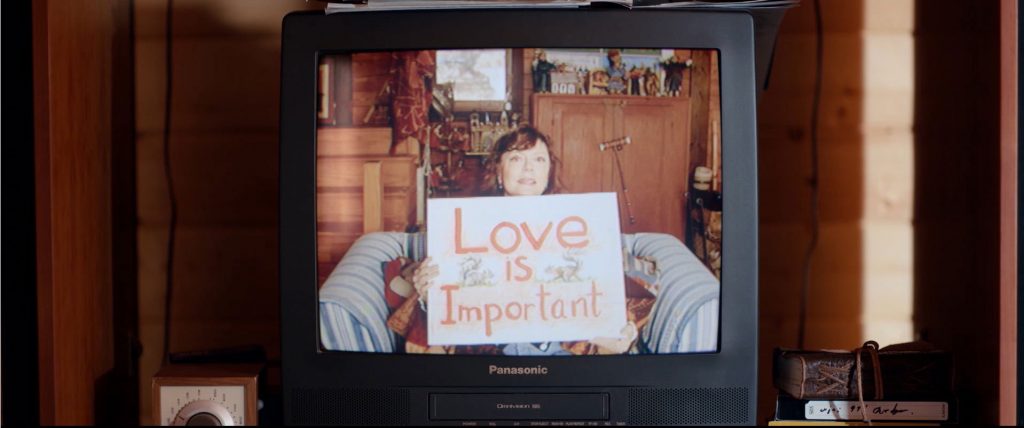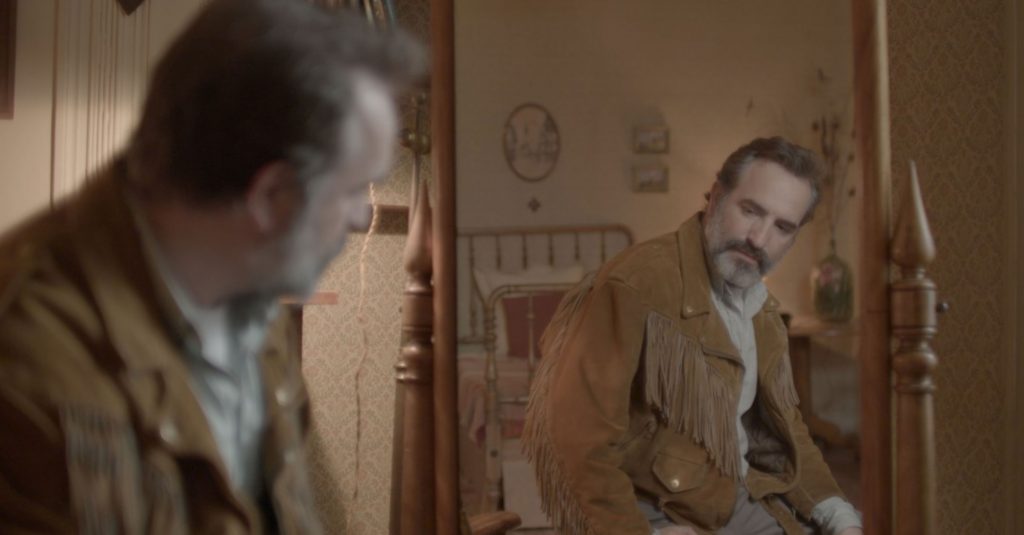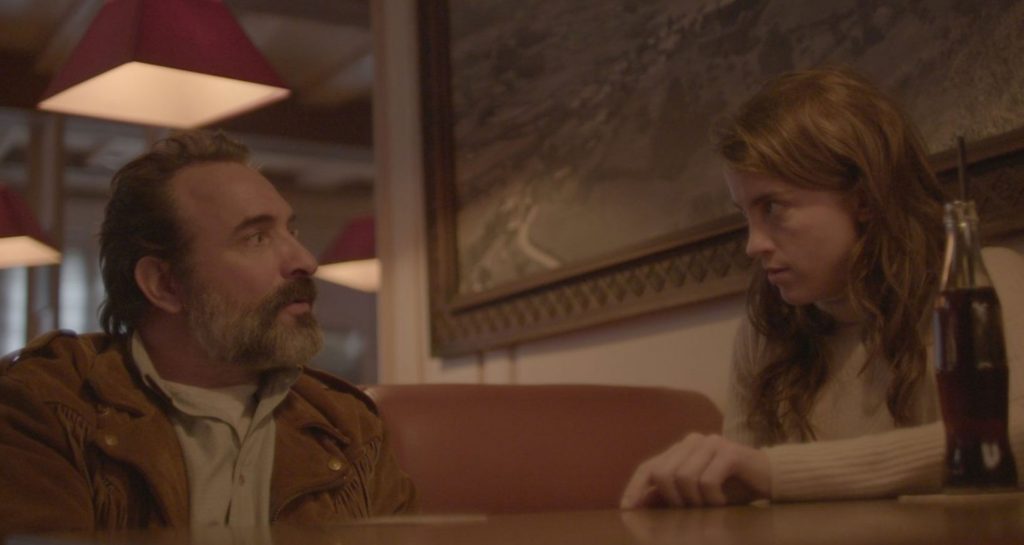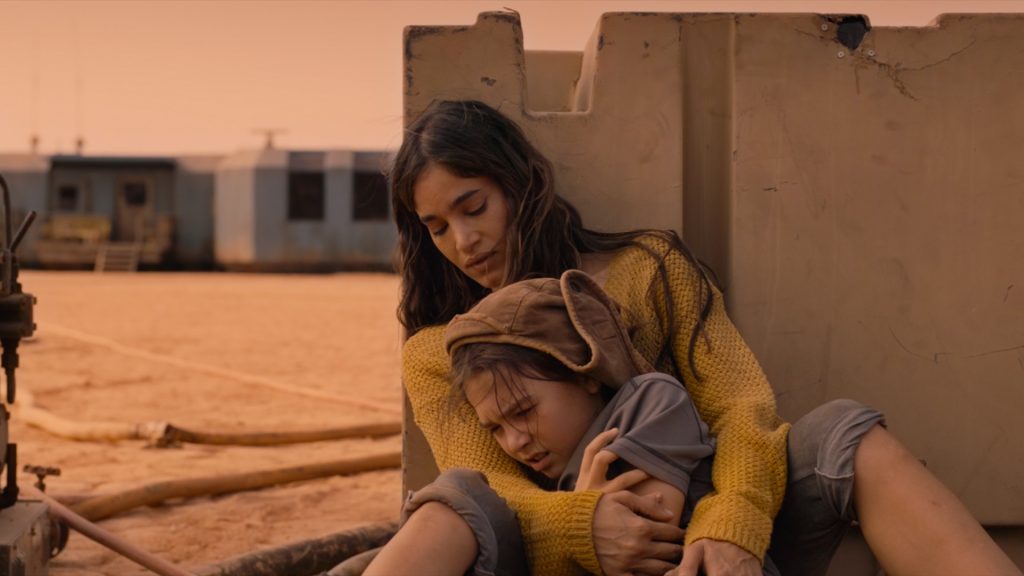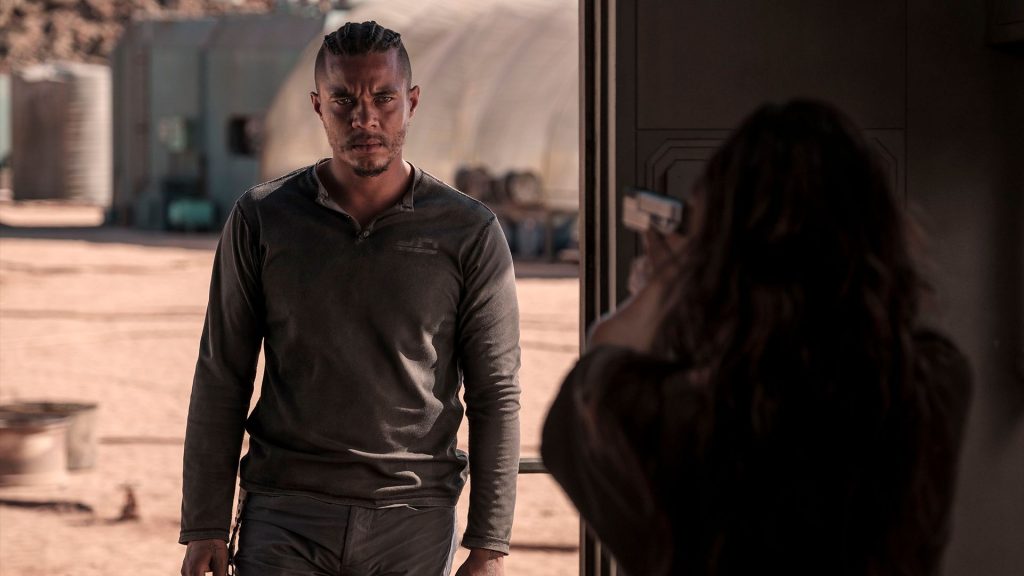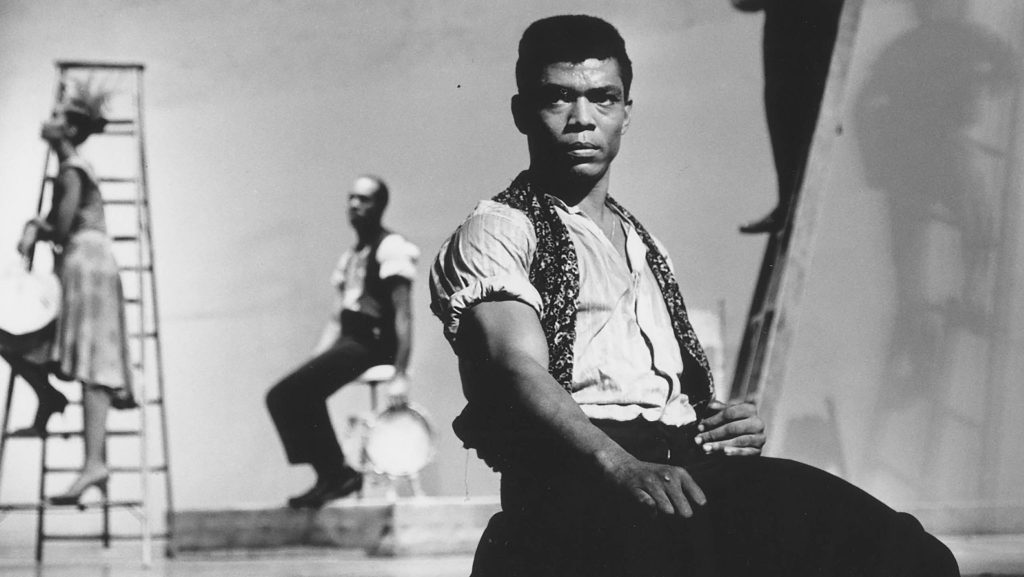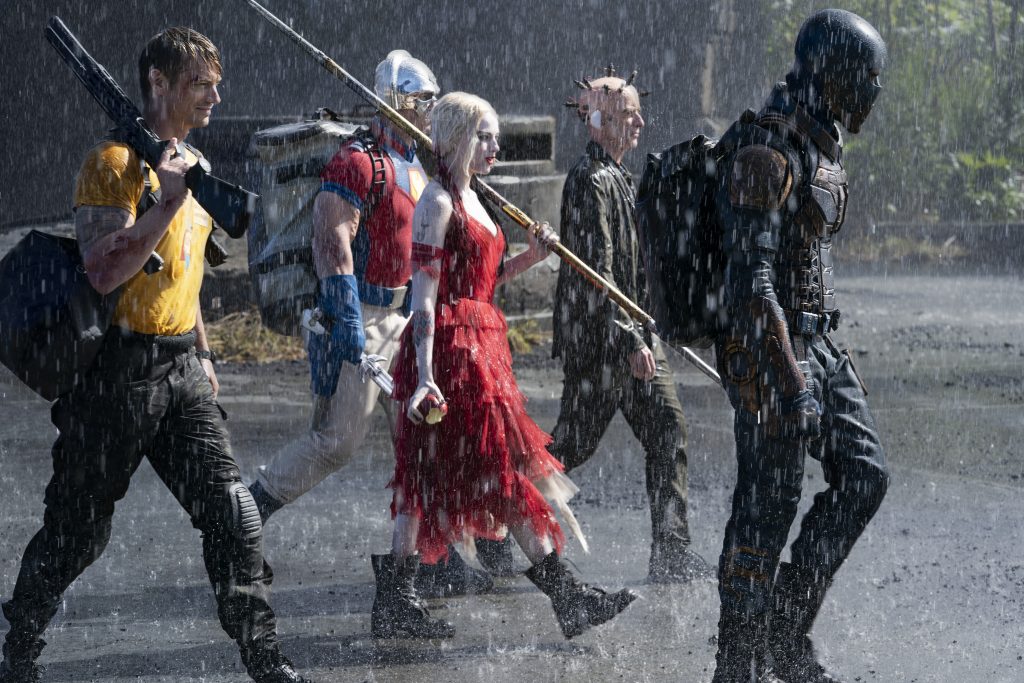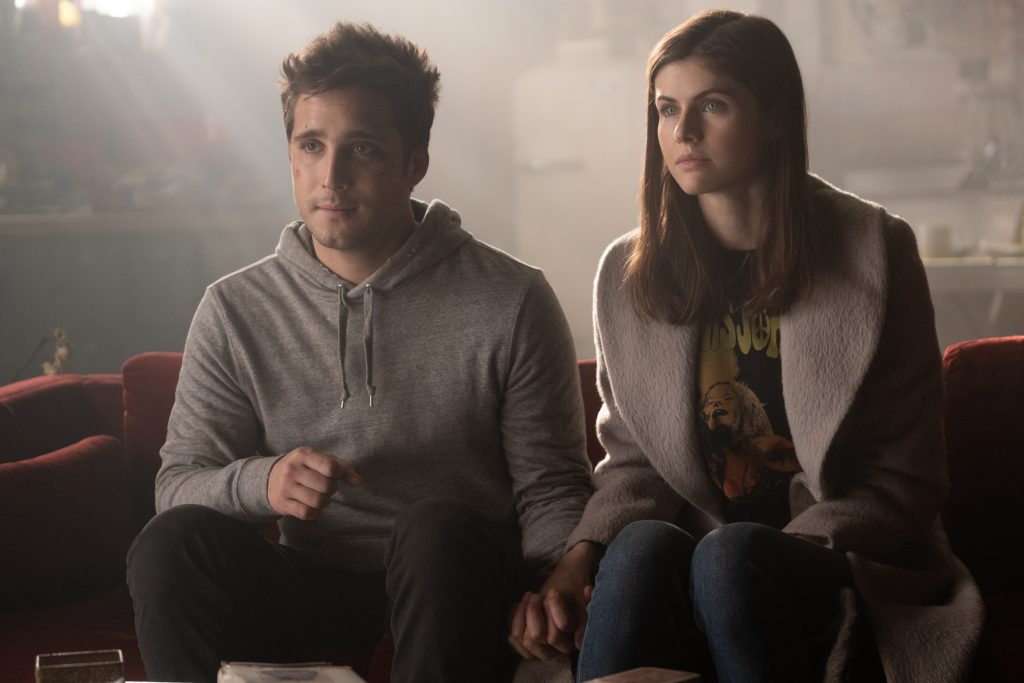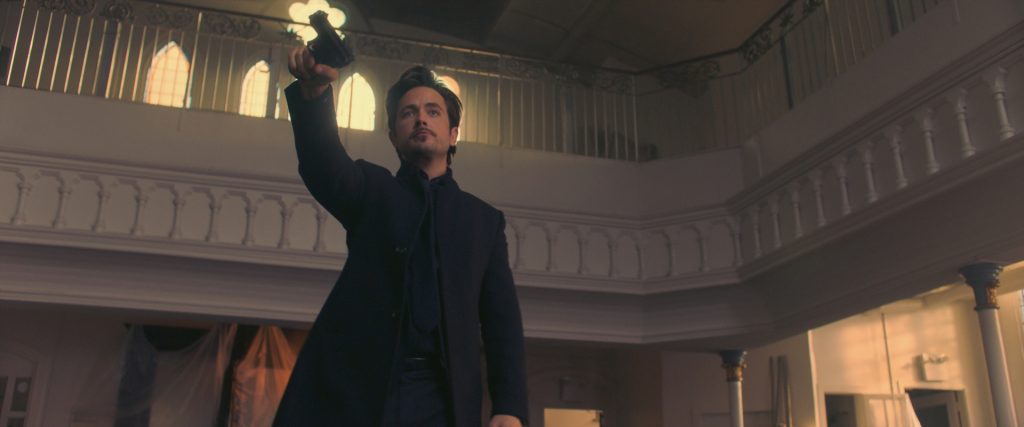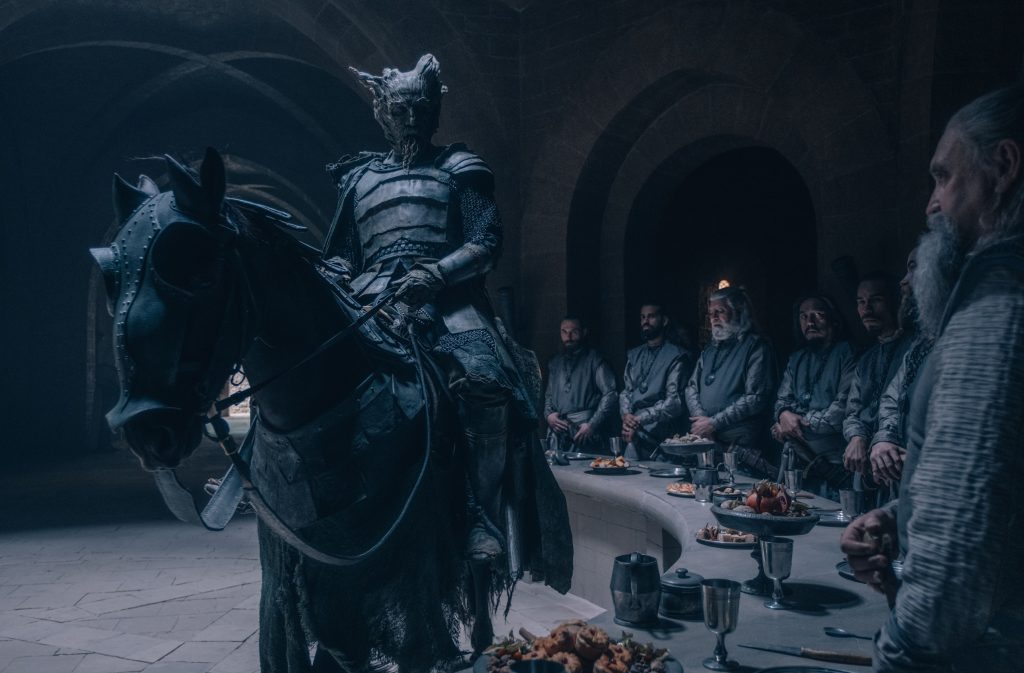August 4, 2021
by Carla Hay
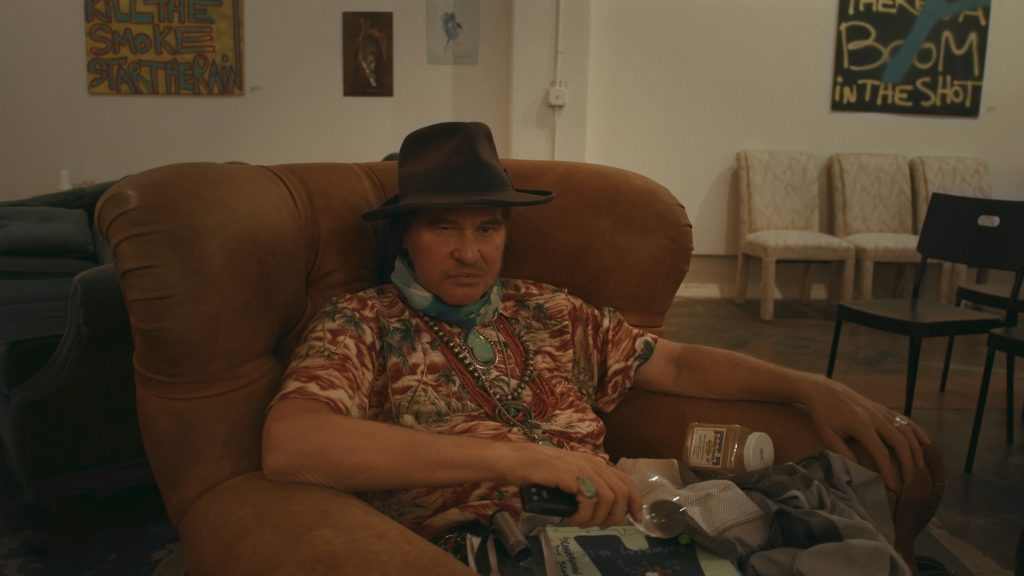
Directed by Leo Scott and Ting Poo
Culture Representation: Taking place primarily in various parts of the world, the documentary film “Val” features an all-white group of people, including actor Val Kilmer, talking about his life, career and legacy.
Culture Clash: Kilmer opens up about his throat cancer, his reputation for being a “difficult” and “eccentric” actor, and conflicts he’s had in his career and personal life.
Culture Audience: Besides the obvious target audience of Val Kilmer fans, “Val” will appeal primarily to people who are interested in non-fiction movies about people with cancer and mainstream movies from the 1980s and 1990s.
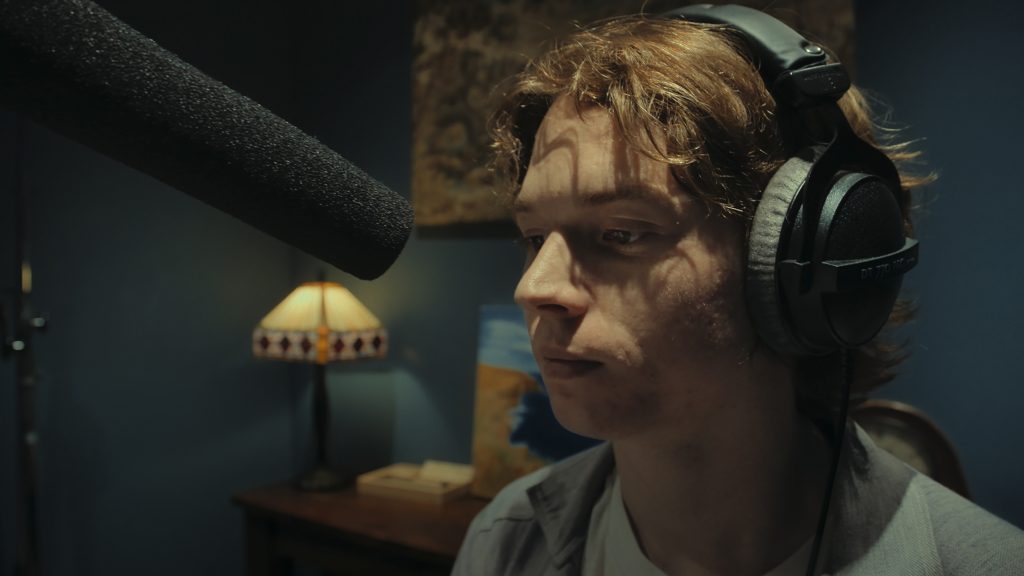
When actor Val Kilmer made his feature-film debut in the 1984 comedy “Top Secret!,” he probably never imagined that his best movie would be an emotionally moving documentary where he looks back on his life while battling throat cancer. He was diagnosed with cancer in 2015, and he now has to use a voice device to speak. The cancer might have robbed Kilmer of the speaking voice that he used to have, but it hasn’t robbed him of his spirit. The documentary “Val” (directed by Leo Scott and Ting Poo) beautifully captures that spirit of this admittedly very flawed human being.
It’s refreshing that the documentary “Val” isn’t like most celebrity documentaries, which are usually filled with interviews of people praising the celebrity and padded with footage that’s already been widely seen by the celebrity’s fans. “Val” is told in Val Kilmer’s own words, with his son Jack Kilmer (who is also an actor) providing much of the voiceover narration. It’s essentially an intriguing movie version of his 2020 autobiography “I’m Your Huckleberry: A Memoir.”
The “Val” documentary also greatly benefits from all the personal archives that Val (who was born on December 31, 1959) admits he has been obsessively compiling from a very young age. Long before social media existed, he was filming himself and his experiences as much as possible. In the beginning of the documentary, he gives a brief tour of the warehouse-sized storage that he has for all the film footage, recordings, photos, scrapbooks and other personal memorabilia that he has amassed. So much of this footage is in the documentary that Val is credited with being a cinematographer for this movie.
Therefore, many of the highlights of “Val” include previously unreleased footage that can be raw, hilarious or sometimes uncomfortable to watch—but never boring. People who watch “Val” can see moments where his fixation on filming his experiences sometimes annoyed people around him. It’s an indication of how this documentary is a lot more honest than most documentaries would be about how a celebrity’s need to be filmed as much as possible can get very negative reactions from people close to the celebrity.
Val comments in the documentary through Jack’s voiceover narration: “I’ve lived a magical life. I have thousands of hours of videotapes and reels I’ve shot of my life and career. I’ve kept everything, and it’s been sitting in boxes for years … I’ve wanted to tell a story about acting for a very long time. Now that it’s more difficult to speak, I want to tell my story now more than ever—a story about my life that is also not my life.” Val then says of his life story in his own voice (which became impaired do to caner radiation treatments), “I know it’s incomplete.”
The documentary opens with some of this personal behind-the-scenes footage of Val on the set of 1986’s “Top Gun.” In this action flick about hotshot aviators in the U.S. Navy, he co-starred alongside Tom Cruise, with Val in the role of antagonist Tom “Iceman” Kazansky. “Top Gun” was Val’s third movie and his first big blockbuster. To this day, much of the memorabilia that he’s asked to autograph is for “Top Gun.”
In the behind-the-scenes footage, Val is shown goofing around in a film-set trailer with “Top Gun” co-star Rick Rossovich. Val holds up a cigarette pack up to his ear like someone would hold a phone to place an order. Val says, “More sex, more drugs, more wine, more headaches, more ulcers, more herpes, more women. And less of Tom Cruise!”
It’s an example of Val’s offbeat sense of humor. Val says in the documentary that although he and Cruise had a real rivalry on the set of “Top Gun,” to mirror the rivalry that their characters had in the movie, they actually became friends in real life. Val says he still has a cordial relationship with Cruise. He also comments that he wasn’t a fan of the “war-mongering” aspect of “Top Gun,” but he appreciates that people enjoyed the movie. Val also jokes in this behind-the-scenes “Top Gun” footage that he’s been fired from every movie he’s ever done.
All joking aside, Val opens up about a tragedy that had a profound impact on him: the death of his beloved younger brother Wesley. Val is the middle of three sons of industrialist/real-estate developer Eugene and Gladys Kilmer, who got divorced when he was 8 years old. The three children (Val, his older brother Mark and younger brother Wesley) were raised in a comfortably upper-middle-class household in Chatsworth, California, where his high school classmates included future famous actors Kevin Spacey and Mare Winningham. The Kilmer kids also had a charmed life at that time, which included living in a home that used to be owned by Roy Rogers, one of Val’s early idols.
Val describes his father as a business wheeler dealer, who owned a company called Liberty Engineering, and who used his power and influence to get full custody of his kids in the divorce. Val says his mother Gladys was “a spiritual woman who loved horses,” “an enigma” and “strong but aloof.” She eventually remarried and moved to Arizona. The three Kilmer brothers had a passion for filmmaking from an early age and spent a lot of time making short films together. There’s footage of one of those childhood short films called “Teeth,” which is about a killer shark.
Val says that Wesley was an aspiring film director and “an artistic genius whose imagination dwarfed mine.” In addition to acting in homemade short films, Val got involved in acting in school plays. And he was thrilled when, at age 17, he got accepted into the Juilliard School, a prestigious artistic university in New York City. Val claims he was the youngest person to be enrolled as a Juilliard student at the time. (The documentary has no verification from Juilliard to determine that this claim is true.)
While at Juilliard, Val says that he and other students helped create a playwright department because the school didn’t have one at the time. He collaborated with other students to stage the play “How It All Began,” based on German terrorist Michael Baumann’s memoir. He says, “I experienced the joy of performing my own words on stage. It was life-changing.” The play was so good that the students were invited to perform it on a real New York stage with paying customers, not just within the confines of the school.
The documentary includes new footage of Val taking his son Jack to Juilliard to show him around the school. Val points to an oversized photo of one of Juilliard’s former students, and asks Jack if he knows who that person is. Jack says no, and Val says it’s Kelly McGillis, who was one of the co-stars of “Top Gun.” In another part of the movie, Val says he and McGillis became good pals while filming “Top Gun,” partly because of their Juilliard connection.
While in his first year at Juilliard, Val got devastating news: Wesley died of an epileptic seizure while in a jacuzzi. He was 15 years old. As he says in the documentary, “My confidant disappeared into dust. Our family was never the same.” He also describes “being raw with grief” during his first year at Juilliard. And he says that his father Eugene became “a detached and vacant version of himself.”
After graduation, Val went on to do some work in New York theater. In 1983, two years after graduating from Juilliard, he had his first big Broadway break with a starring role in the play “Slab Boys.” In a self-deprecating tone, he talks about getting bumped from the play’s first-lead role to the third-lead role, after Sean Penn became available for the first-lead role, and Kevin Bacon got the second-lead role. There’s backstage footage of all of these future famous actors goofing around in a dressing room during their “Slab Boys” experience.
There’s also footage of Val getting lectured by acting coach Peter Kass during a rehearsal where Val was asked to tap into emotions of wanting to die, and Val says he’s never really felt those emotions. Kass gets irritated and shouts at Val in front of the group that everyone has had those feelings, but some actors are more honest about it than others. “There’s no way you’ve never had those thoughts!” Kass bellows.
Kilmer might have lost out on the starring role in “Slab Boys,” but he got a starring role in the action comedy “Top Secret!,” his first feature film. It was a spy caper with a plot that he calls silly and confusing. He filmed the movie in London, where by chance he saw a play called “The Genius,” directed by future Oscar-winning filmmaker Danny Boyle.
Co-starring in “The Genius” was a British actress named Joanne Whalley, whom Val says he became infatuated with at first sight because of her beauty and talent. He quips in the documentary, “She was brilliant, and I was making fluff.” Val says that he went back to see the play several times because of Whalley. And he even followed her to a pub after one of the shows, but he was too shy to approach her.
She and Val didn’t meet until years later, when they ended up co-starring together on the 1988 fantasy film “Willow.” They got married in 1988. Their daughter Mercedes was born in 1991, and Jack arrived in 1995. The couple relocated to New Mexico (the home state of Val’s paternal grandfather) and got divorced in 1996.
The former couple went through a contentious custody battle because Val wanted to stay in New Mexico, while Whalley wanted to raise the kids in California. The documentary includes an audio recording of Val having a heated phone conversation with her about their custody arrangement. (Only his voice is heard, not hers.)
There’s some family footage from happier times, including Val’s wedding and home videos of him being a doting father when the kids were young. Val also doesn’t shy away from talking about the bad times, such as when he lost a lot of money from shady business deals that his father got Val mixed up in after Val became a movie star in the 1980s. Val says that he had the choice to either sue his father or just pay off his father’s debts, and he chose to pay off the debts.
Whatever pain was caused by Val’s divorce, his children certainly have a good relationship with him now. He lights up every time he’s around them. And in one of the movie’s more poignant moments, Val, his ex-wife and their kids are shown as they gather in Arizona for the funeral of Val’s mother, who died in 2019. It’s the part of the movie where Val seems to be the most vulnerable. He puts on one of her necklaces, and he tears up when he says, “I miss my mama, but I had a vision that she was so happy with her youngest son.”
“Val” also has some insightful footage about some of his experiences in his more famous movies. Many of his fans already know that he used Method acting to immerse himself in the role of rock singer/poet Jim Morrison for 1991’s “The Doors,” directed by Oliver Stone. There’s some behind-the-scenes footage of him rehearsing in character as Morrison. He admits in the documentary that making “The Doors” was an all-consuming process that was very difficult on his marriage: “For my wife, Joanne, it was total hell. Home was just another place [for me] to rehearse.”
“The Doors” movie got mixed reactions from critics and audiences, but almost everyone agreed that Val’s uncannily accurate portrayal of Morrison was the best thing about “The Doors.” (Val did his own singing in the movie.) Although he’s never been nominated for an Oscar for his acting, his highly praised performance in “The Doors” was the closest that he came to getting an Oscar nomination. In several interviews over the years, Val has said that out of all of his movie roles, his portrayal of Jim Morrison was the one that personally affected him the most.
For his starring role in 1995’s “Batman Forever,” he hated the heaviness of the Batman suit because it limited his movements and ability to hear. He says in the documentary, “It was a struggle for me to get a performance past the suit, until I realized my role in the film was just to show up and stand where I was told to.” Ironically, Val says that when he got the call to do the movie, he was in a bat cave in Africa. Who really knows if that’s true? But it makes a great anecdote.
Even though “Batman Forever” was a massive hit and he was offered millions to do a follow-up “Batman” movie, he declined the offer and chose instead to do the 1997 spy film “The Saint,” because he got to play a character who had different personas like a chameleon. And it seems Val dodged a bullet by doing that next “Batman” movie, because it was 1997’s much-ridiculed “Batman and Robin,” starring George Clooney as Batman. (The documentary includes some satirical home video footage of a present-day Val and his son Jack dressed as Batman and Robin, respectively.)
At times in the documentary, Val acknowledges that his reputation for being a “difficult” actor was probably accurate. “I’ve behaved poorly, and I’ve behaved bravely,” he says. However, from watching this documentary, you get the feeling that Val has no overall regrets about his career choices because he feels lucky that he’s had a lot of great experiences and got to work with many of his actor idols. He describes the day that he finished shooting “Batman Forever,” he walked onto the set of his next movie: 1995’s crime drama “Heat,” directed by Michael Mann and co-starring Robert De Niro and Al Pacino. “‘Heat’ felt like an indie film,” Val remembers.
Val also got to work with Marlon Brando, perhaps his biggest actor idol, in a movie that had a much more tortuous production: 1996’s “The Island of Dr. Moreau,” which was a massive flop. Tensions were already running high because the movie’s original director (Richard Stanley) was fired, and replacement director John Frankenheimer did not endear himself to many people in the cast and crew. Two of the principal actors (Bruce Willis and Rob Morrow) quit the movie. Val was the replacement for Willis as the Dr. Montgomery character. Val calls the “The Island of Dr. Moreau” a “doomed” movie. And it also has bad memories for him because he got served divorce papers on the film set.
Behind the scenes, Val and Frankenheimer clashed on the set. (The movie includes footage of some of their arguing.) The way Val describes it, Frankenheimer didn’t really know how to direct the movie, and the director was more concerned about rushing to finish the over-budget movie than the quality of the film. Val also says that Frankenheimer made the mistake of alienating Brando by not listening to any of Brando’s suggestions.
Meanwhile, the behind-the-scenes footage shows that Val insisted that he could only act in a scene if he was in the right frame of mind. Frankenheimer was also clearly irritated by Val filming this behind-the-scenes footage, which includes Frankenheimer ordering Val to turn off the camera, and Val ignoring the request, which caused Frankenheimer to get even angrier. In other behind-the-scenes footage on the film set, “The Island of Dr. Moreau” co-stars David Thewlis and Fairuza Balk look like they know they’re stuck in a disastrous movie and are trying to make the best out of a horrible situation.
A laugh-out-loud moment in the documentary is some footage revealing that things got so bad during filming of “The Island of Dr. Moreau” that Brando refused to come to work on some days, so they got his body double named Norm to film some of Brando’s scenes. Brando’s Dr. Moreau character wore heavy white makeup, so it was possible to disguise that it really wasn’t Brando in the scene where the character wasn’t required to speak. (It probably wasn’t funny at the time, but it’s funny to look at now.) A priceless moment in the documentary is footage of Val sneaking up on Brando, who’s resting in a hammock at night, and Val pushes the hammock like someone would push a child on a swing.
Not all of the documentary is about showing Val’s life at the height of his career. There’s also footage of a post-cancer Val attending fan conventions, which he says he needs to do to supplement his income. He makes money at these events by meet-and-greet sessions, where fans pay to get his autograph and get photos with him. At a tribute event in Texas for Val and his 1993 film “Tombstone,” Val has a moment alone where he looks sad and makes a confession.
Val says, “Sometimes I have the blues about having to fly around the country. I don’t look great, and I’m basically selling my old self, my old career. For many people, it’s the worst thing you can do … But it allows me to meet my fans. What ends up happening is I feel really grateful rather than humiliated, because there are so many people.”
Before his voice was impaired by cancer, Val was able to fulfill his dream of portraying Mark Twain (one of his artistic idols) on stage. In order to pay off his debts and get the money for the play, he sold 6,000 acres of land that he owned in New Mexico and that he had hoped would be part of his legacy to his children. He spent years writing the one-man play “Citizen Twain,” which went to several U.S. cities and probably would have continued as a touring production if Val hadn’t had gotten cancer.
Val seems to have taken his health condition in stride and wants to make the most out of the time that he has left on this earth. The documentary mentions that after his cancer diagnosis, he founded HelMel Studios, a Los Angeles-based gathering space for artists. And one of the most memorable things he says in the documentary perhaps best sums up why his life story can resonate with so many people: “I don’t believe in death. And my whole life, I’ve tried to see the world as one piece of life. When you pull back from the planet, you see that we are all one life source.”
Amazon Studios and A24 Distribution released “Val” in select U.S. cinemas on July 23, 2021. The movie’s premiere on Amazon Prime Video is on August 6, 2021.


